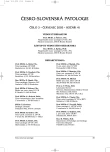Diagnosis of Traumatical and Hypoxial Changes of the CNS – Immunohistochemical Study
Authors:
P. Toupalík; I. Bouška
Authors‘ workplace:
Institut of Forensic Medicine Charles University, 2nd Medical Fakulty, Praha
Published in:
Soud Lék., 50, 2005, No. 3, p. 42-44
Overview
The immunohistochemical detection of neuron-specific enolase and b-amyloid percursor protein were used in the group of deceased on craniocerebral injury and those who died of prolonged hypoxy without mechanical injury of the brain. Neuron-specific enolase (NSE) is produced by nerve cells and is a suitable marker for both the damage of neurons and axons. While undamaged nerve cells show immunoreactivity with the antibody anti-NSE, a significant decrease of this protein substance was noticed within two hours both in mechanical injury and in cases of prolonged hypoxy.We noticed the presence of NSE in damaged axons already several minutes after the injury whereas the hypoxy of brain without mechanical injury didn’t show any or a very slight reaction of axons when examined with anti-NSE without topographic link to axonal lesion. bamyloid percursor protein (b-APP) is a low molecular protein which the normal values of are not to be found in axons detected by standard immunohistochemistry. We noticed an increased frequency of appearance of this protein substance in axons changed by injury, while a reactive positivity to anti-body b-APP was to be found only rarely at the brain hypoxy without mechanical injury CNS.
Key words:
brain injury – immunohistochemistry – neuron specific enolase – b-amyloid percursor protein – diffuse axonal injury – hypoxy
Labels
Anatomical pathology Forensic medical examiner ToxicologyArticle was published in
Forensic Medicine

2005 Issue 3
Most read in this issue
- Death Due to Fatal Hypothermia in Victims Dissected in Department of Forensic Medicine in Hradec Králové Between 1992–2003
- Diagnosis of Traumatical and Hypoxial Changes of the CNS – Immunohistochemical Study
- Possibility of Use Digital of Imaging in Forensic Medicine
